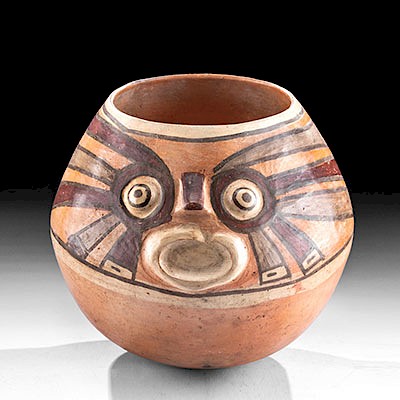Etruscan Bronze Handle w/ Female Sphinxes, Silver Inlay
Lot 45
About Seller
Artemis Gallery
686 S Taylor Ave, Ste 106
Louisville, CO 80027
United States
Selling antiquities, ancient and ethnographic art online since 1993, Artemis Gallery specializes in Classical Antiquities (Egyptian, Greek, Roman, Near Eastern), Asian, Pre-Columbian, African / Tribal / Oceanographic art. Our extensive inventory includes pottery, stone, metal, wood, glass and textil...Read more
Categories
Estimate:
$5,000 - $8,000
Absentee vs Live bid
Two ways to bid:
- Leave a max absentee bid and the platform will bid on your behalf up to your maximum bid during the live auction.
- Bid live during the auction and your bids will be submitted real-time to the auctioneer.
Bid Increments
| Price | Bid Increment |
|---|---|
| $0 | $25 |
| $300 | $50 |
| $1,000 | $100 |
| $2,000 | $250 |
| $5,000 | $500 |
| $10,000 | $1,000 |
| $20,000 | $2,500 |
| $50,000 | $5,000 |
| $100,000 | $10,000 |
| $200,000 | $20,000 |
About Auction
By Artemis Gallery
Dec 5, 2019
Set Reminder
2019-12-05 10:00:00
2019-12-05 10:00:00
America/New_York
Bidsquare
Bidsquare : Ancient / Ethnographic - Holiday Edition
https://www.bidsquare.com/auctions/artemis-gallery/ancient-ethnographic---holiday-edition-4710
What to give this holiday season? Ancient & Ethnographic Art of course! Our special Holiday auction features hundreds of unique finds from all over the world. Artemis Gallery info@artemisgallery.com
What to give this holiday season? Ancient & Ethnographic Art of course! Our special Holiday auction features hundreds of unique finds from all over the world. Artemis Gallery info@artemisgallery.com
- Lot Description
Classical World, Etruria, ca. 6th to 5th century BCE. Expertly cast via the lost wax (cire perdue) process, a fascinating bronze handle depicting a pair of sirens, each with the head of a woman, eagle wings, and the body of a lion and presenting traces of silver inlay in places, below the beautifully modeled handle presenting elegantly ridged borders and a central bas-relief long stemmed flower. An exquisite bronze handle, replete with impressive style, technique, and iconography - certainly worthy of an opulent vessel that was perhaps used to impress guests at a banquet or symposium. Size: 2.625" W x 7" H (6.7 cm x 17.8 cm); 8.875" H (22.5 cm) on included custom stand.
Although the Great Sphinx of Giza is certainly the most famous, sphinxes have a large place in Classical mythology as well - probably because of the intermixing of Egyptian and Classical culture via trade routes across the Mediterranean. The Classical version of the sphinx, unlike the male Egyptian one, has the head of a human female, the body of a lioness, the wings of an eagle, and a serpent's tail.
Provenance: private New Jersey, USA collection; ex-Ancient Resource Auctions, Montrose, California, USA; ex-Los Angeles, California, USA collection
All items legal to buy/sell under U.S. Statute covering cultural patrimony Code 2600, CHAPTER 14, and are guaranteed to be as described or your money back.
A Certificate of Authenticity will accompany all winning bids.
We ship worldwide and handle all shipping in-house for your convenience.
#150266Areas of loss to upper end of the handle and peripheries of the sphinx relief at the lower end. Minute nicks to high relief ridges of the handle and high-pointed areas of the sphinx relief.Condition
- Shipping Info
-
All shipping is handled in-house for your convenience. Your invoice from Artemis Gallery will include shipping calculation instructions. If in doubt, please inquire BEFORE bidding for estimated shipping costs for individual items.
-
- Buyer's Premium



 EUR
EUR CAD
CAD AUD
AUD GBP
GBP MXN
MXN HKD
HKD CNY
CNY MYR
MYR SEK
SEK SGD
SGD CHF
CHF THB
THB














